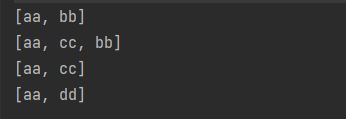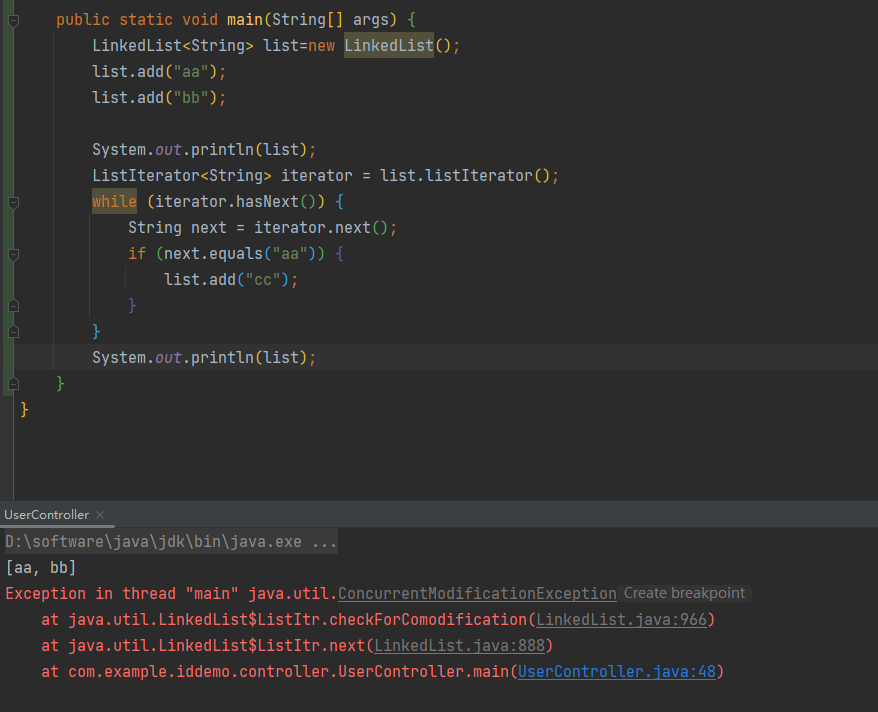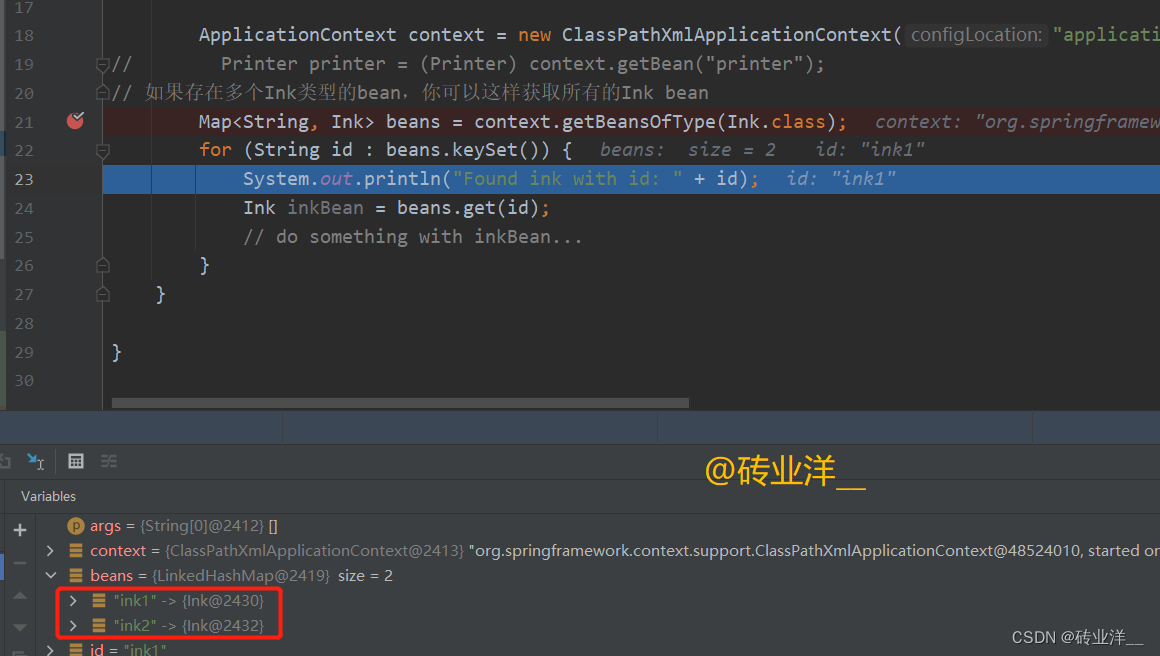介绍
- 基于双向链表实现
- 线程不安全
- 插入删除效率较高,但不支持随机查找
public class LinkedList<E>extends AbstractSequentialList<E>implements List<E>, Deque<E>, Cloneable, java.io.Serializable

常量&变量
// 元素数量transient int size = 0;/*** Pointer to first node.* Invariant: (first == null && last == null) ||* (first.prev == null && first.item != null)* 头节点*/transient Node<E> first;/*** Pointer to last node.* Invariant: (first == null && last == null) ||* (last.next == null && last.item != null)* 尾节点*/transient Node<E> last;
LinkedList 的底层数据结构为双向链表,每个节点包含两个引用,prev指向当前节点前一个节点,next指向当前节点后一个节点,可以从头结点遍历到尾结点,也可以从尾结点遍历到头结点。

构造方法
/*** Constructs an empty list.* 无参构造 创建一个空集合*/public LinkedList() {}/*** Constructs a list containing the elements of the specified* collection, in the order they are returned by the collection's* iterator.** @param c the collection whose elements are to be placed into this list* @throws NullPointerException if the specified collection is null*/public LinkedList(Collection<? extends E> c) {//调用无参,创建一个空集合this();addAll(c);}
内部类
ListItr
ListItr类定义在LinkedList类的内部(作为普通内部类),它实现了ListIterator接口,具有迭代器的功能。
private class ListItr implements ListIterator<E> {//上一次执行next()或previos()方法时的节点private Node<E> lastReturned;//下一次即将访问的元素(后继节点)private Node<E> next;//下一次要访问的元素的索引(后继节点的索引)private int nextIndex;//将修改次数modCount赋给expectedModCount 预期的修改次数 = 实际修改次数private int expectedModCount = modCount;ListItr(int index) {// assert isPositionIndex(index);//根据索引获得后继节点next = (index == size) ? null : node(index);//后继节点的索引nextIndex = index;}//判断是否有下一个元素可访问public boolean hasNext() {//nextIndex小于size表示仍然还有后继结点,如果大于等于size那么表示要么是尾结点,要么索引越界了return nextIndex < size;}//获取下一个访问的元素public E next() {checkForComodification();//如果没有下一个元素if (!hasNext())//抛出NoSuchElementException异常throw new NoSuchElementException();//保存当前遍历的节点lastReturned = next;//下个节点next = next.next;//索引加1nextIndex++;//返回旧next节点的元素return lastReturned.item;}//判断是否有上一个元素可访问public boolean hasPrevious() {//向前遍历,当索引大于0,表示前驱节点存在return nextIndex > 0;}//获取上一个访问的元素public E previous() {checkForComodification();if (!hasPrevious())throw new NoSuchElementException();lastReturned = next = (next == null) ? last : next.prev;nextIndex--;return lastReturned.item;}//获取下一个访问的元素在线性表中的索引public int nextIndex() {return nextIndex;}//获取上一个访问元素在线性表中的索引public int previousIndex() {return nextIndex - 1;}/*** 使用迭代器进行迭代的时候不能进行调用list.remove()或list.add()删除修改元素,否则会抛出ConcurrentModificationException异常* 所以如果要增加或删除元素需要使用迭代器Iterator内部的remove()和add()方法*///删除元素public void remove() {checkForComodification();if (lastReturned == null)throw new IllegalStateException();//后继节点Node<E> lastNext = lastReturned.next;//删除当前节点unlink(lastReturned);//next 和 上一次遍历的节点 是同一个对象 说明是向前遍历if (next == lastReturned)next = lastNext;elsenextIndex--;//置null 便于回收lastReturned = null;expectedModCount++;}public void set(E e) {if (lastReturned == null)throw new IllegalStateException();checkForComodification();lastReturned.item = e;}//添加public void add(E e) {checkForComodification();lastReturned = null;if (next == null)//当前节点是尾结点,直接在尾部添加linkLast(e);else//插入到next节点前linkBefore(e, next);nextIndex++;expectedModCount++;}public void forEachRemaining(Consumer<? super E> action) {Objects.requireNonNull(action);while (modCount == expectedModCount && nextIndex < size) {action.accept(next.item);lastReturned = next;next = next.next;nextIndex++;}checkForComodification();}final void checkForComodification() {if (modCount != expectedModCount)throw new ConcurrentModificationException();}}
ListItr类不仅可以遍历元素,还可以遍历元素时添加、删除元素
ListItr类定义在LinkedList的内部,每个ListItr对象隐式持有LinkedList对象的引用,该迭代器在遍历时对ListItr对象添加、删除、修改元素,都会影响到LinkedList对象
public static void main(String[] args) {LinkedList<String> list=new LinkedList();list.add("aa");list.add("bb");System.out.println(list);ListIterator<String> iterator = list.listIterator();while (iterator.hasNext()) {String next = iterator.next();if (next.equals("aa")) {iterator.add("cc");}}System.out.println(list);ListIterator<String> iterator2 = list.listIterator();while (iterator2.hasNext()) {String next = iterator2.next();if (next.equals("bb")){iterator2.remove();}}System.out.println(list);ListIterator<String> iterator3 = list.listIterator();while (iterator3.hasNext()) {String next = iterator3.next();if (next.equals("cc")){iterator3.set("dd");}}System.out.println(list);}

对集合使用迭代器遍历时,可以使用迭代器内部的remove()或add()方法对集合中元素进行增删操作
注:使用list的remove()或add()方法会报ConcurrentModificationException,list无set(E e)方法

Node
Node类就是LinkedList中元素的包装类,表示LinkedList中的一个一个元素
private static class Node<E> {//元素E item;//后节点Node<E> next;//前节点Node<E> prev;Node(Node<E> prev, E element, Node<E> next) {this.item = element;this.next = next;this.prev = prev;}}
DescendingIterator
为listitter .previous提供降序迭代器的适配器,即从LinkedList的列表末尾开始,逆序遍历进而到达列表头部。
/*** Adapter to provide descending iterators via ListItr.previous*/private class DescendingIterator implements Iterator<E> {private final ListItr itr = new ListItr(size());public boolean hasNext() {return itr.hasPrevious();}public E next() {return itr.previous();}public void remove() {itr.remove();}}
LLSpliterator
用于并行流的可分割式迭代器
/** A customized variant of Spliterators.IteratorSpliterator */static final class LLSpliterator<E> implements Spliterator<E> {static final int BATCH_UNIT = 1 << 10; // batch array size incrementstatic final int MAX_BATCH = 1 << 25; // max batch array size;final LinkedList<E> list; // null OK unless traversedNode<E> current; // current node; null until initializedint est; // size estimate; -1 until first neededint expectedModCount; // initialized when est setint batch; // batch size for splitsLLSpliterator(LinkedList<E> list, int est, int expectedModCount) {this.list = list;this.est = est;this.expectedModCount = expectedModCount;}final int getEst() {int s; // force initializationfinal LinkedList<E> lst;if ((s = est) < 0) {if ((lst = list) == null)s = est = 0;else {expectedModCount = lst.modCount;current = lst.first;s = est = lst.size;}}return s;}public long estimateSize() { return (long) getEst(); }public Spliterator<E> trySplit() {Node<E> p;int s = getEst();if (s > 1 && (p = current) != null) {int n = batch + BATCH_UNIT;if (n > s)n = s;if (n > MAX_BATCH)n = MAX_BATCH;Object[] a = new Object[n];int j = 0;do { a[j++] = p.item; } while ((p = p.next) != null && j < n);current = p;batch = j;est = s - j;return Spliterators.spliterator(a, 0, j, Spliterator.ORDERED);}return null;}public void forEachRemaining(Consumer<? super E> action) {Node<E> p; int n;if (action == null) throw new NullPointerException();if ((n = getEst()) > 0 && (p = current) != null) {current = null;est = 0;do {E e = p.item;p = p.next;action.accept(e);} while (p != null && --n > 0);}if (list.modCount != expectedModCount)throw new ConcurrentModificationException();}public boolean tryAdvance(Consumer<? super E> action) {Node<E> p;if (action == null) throw new NullPointerException();if (getEst() > 0 && (p = current) != null) {--est;E e = p.item;current = p.next;action.accept(e);if (list.modCount != expectedModCount)throw new ConcurrentModificationException();return true;}return false;}public int characteristics() {return Spliterator.ORDERED | Spliterator.SIZED | Spliterator.SUBSIZED;}}
常用方法
add

/*** Appends the specified element to the end of this list.** <p>This method is equivalent to {@link #addLast}.** @param e element to be appended to this list* @return {@code true} (as specified by {@link Collection#add})* 插入尾部,并返回true 与addLast方法等价*/public boolean add(E e) {linkLast(e);return true;}/*** Inserts the specified element at the specified position in this list.* Shifts the element currently at that position (if any) and any* subsequent elements to the right (adds one to their indices).** @param index index at which the specified element is to be inserted* @param element element to be inserted* @throws IndexOutOfBoundsException {@inheritDoc}*/public void add(int index, E element) {checkPositionIndex(index);if (index == size)//尾部添加linkLast(element);else//在索引对应的节点前插入elementlinkBefore(element, node(index));}
checkPositionIndex
private void checkPositionIndex(int index) {//不符合条件 报错if (!isPositionIndex(index))throw new IndexOutOfBoundsException(outOfBoundsMsg(index));}/*** Tells if the argument is the index of a valid position for an* iterator or an add operation.* 参数index是否符合条件*/private boolean isPositionIndex(int index) {return index >= 0 && index <= size;}
linkLast
在尾部添加元素
/*** Links e as last element.*/void linkLast(E e) {// 获取尾部元素final Node<E> l = last;// 实例化一个新的节点,前一个节点为l,当前节点为传入的添加节点,下一个节点为nullfinal Node<E> newNode = new Node<>(l, e, null);// 将尾部节点进行更新(添加上新加入的节点)last = newNode;// 当尾部节点为空时,头节点即为新添加的节点if (l == null)first = newNode;// 否则,尾部节点的下一个为新添加的节点elsel.next = newNode;// 元素数量+1size++;// 修改次数+1modCount++;}
linkBefore
/*** Inserts element e before non-null Node succ.* 在非空节点succ前,插入元素 e*/void linkBefore(E e, Node<E> succ) {// assert succ != null;//原index对应节点succ的前驱节点final Node<E> pred = succ.prev;//创建新的节点 pred <-- e --> succfinal Node<E> newNode = new Node<>(pred, e, succ);//succ的前驱节点为newNode pred <-- e <--> succ succ.prev = newNode;if (pred == null)// e <--> succ first = newNode;else//pred的后继节点为newNode pred <--> e <--> succ pred.next = newNode;size++;modCount++;}
addAll

/*** Appends all of the elements in the specified collection to the end of* this list, in the order that they are returned by the specified* collection's iterator. The behavior of this operation is undefined if* the specified collection is modified while the operation is in* progress. (Note that this will occur if the specified collection is* this list, and it's nonempty.)** @param c collection containing elements to be added to this list* @return {@code true} if this list changed as a result of the call* @throws NullPointerException if the specified collection is null* 将指定集合中的所有元素追加到此列表的末尾。*/public boolean addAll(Collection<? extends E> c) {return addAll(size, c);}/*** Inserts all of the elements in the specified collection into this* list, starting at the specified position. Shifts the element* currently at that position (if any) and any subsequent elements to* the right (increases their indices). The new elements will appear* in the list in the order that they are returned by the* specified collection's iterator.** @param index index at which to insert the first element* from the specified collection* @param c collection containing elements to be added to this list* @return {@code true} if this list changed as a result of the call* @throws IndexOutOfBoundsException {@inheritDoc}* @throws NullPointerException if the specified collection is null* 将指定集合(Collection c)中的所有元素插入到此列表中,从指定的位置(index)开始。*/public boolean addAll(int index, Collection<? extends E> c) {//判断索引是否越界checkPositionIndex(index);//通过指定集合获得数组Object[] a = c.toArray();//数组的长度int numNew = a.length;//长度为空,直接返回失败if (numNew == 0)return false;//节点的前驱节点、后继节点Node<E> pred, succ;//直接从尾部添加该集合if (index == size) {//后继节点为null,前驱节点为尾节点succ = null;pred = last;} else {//指定索引对应的节点为后继节点,节点的前节点为前驱节点succ = node(index);pred = succ.prev;}//遍历数组for (Object o : a) {//类型转换@SuppressWarnings("unchecked") E e = (E) o;//构造新节点 pred <-- eNode<E> newNode = new Node<>(pred, e, null);if (pred == null)//新节点为头节点 efirst = newNode;else//前驱节点的下一个节点为新节点 pred <--> epred.next = newNode;//为了下个循环,将新节点置为前驱节点pred = newNode;}//如果后继节点为null(尾部插入的情况),前驱节点就是尾结点if (succ == null) {// pred <--> elast = pred;} else {//前驱节点的后节点为后继节点 pred <--> e --> succpred.next = succ;//后继节点的前节点为前驱节点 pred <--> e <--> succsucc.prev = pred;}size += numNew;modCount++;return true;}
remove(int index)

/*** Removes the element at the specified position in this list. Shifts any* subsequent elements to the left (subtracts one from their indices).* Returns the element that was removed from the list.** @param index the index of the element to be removed* @return the element previously at the specified position* @throws IndexOutOfBoundsException {@inheritDoc}* 删除指定下标的元素*/public E remove(int index) {// 检测下标是否越界checkElementIndex(index);// 调用unlink删除元素return unlink(node(index));}/*** Unlinks non-null node x.*/E unlink(Node<E> x) {// assert x != null;// 获取当前元素final E element = x.item;// 获取下一个节点final Node<E> next = x.next;// 获取上一个节点final Node<E> prev = x.prev;// 当上一个节点为null时,将当前节点的下一个节点设置为头节点if (prev == null) {first = next;// 不为null时,将上一个节点的下一个节点设置为当前节点的下一个节点(跳过当前元素),然后将当前节点的前一个节点设置为null,断开连接} else {prev.next = next;x.prev = null;}// 当下一个节点为null时,将尾节点设置为上一个节点if (next == null) {last = prev;// 否则将下一个节点的前一个节点设置为前一个节点,并且将当前节点的下一个节点设置为null,断开连接} else {next.prev = prev;x.next = null;}// 设置当前元素为nullx.item = null;// 元素数量-1size--;// 修改次数+1modCount++;// 返回当前元素return element;}
remove()
/*** Retrieves and removes the head (first element) of this list.** @return the head of this list* @throws NoSuchElementException if this list is empty* @since 1.5* 删除头节点*/public E remove() {// 直接调用removeFirst,删除头节点return removeFirst();}/*** Removes and returns the first element from this list.** @return the first element from this list* @throws NoSuchElementException if this list is empty*/public E removeFirst() {// 获取头节点final Node<E> f = first;// 头节点为null时直接抛出if (f == null)throw new NoSuchElementException();// 调用删除头节点的方法return unlinkFirst(f);}/*** Unlinks non-null first node f.*/private E unlinkFirst(Node<E> f) {// assert f == first && f != null;// 获取当前元素final E element = f.item;// 获取下一个节点final Node<E> next = f.next;// 将当前元素设置为nullf.item = null;// 将下一个节点设置为nullf.next = null; // help GC// 因为为删除头节点,所以将头节点设置为下一个节点(跳过当前头节点)first = next;// 当下一个节点为null时,尾节点设置为nullif (next == null)last = null;// 否则下一个节点的前一个节点设置为null,断开与之前头节点的连接elsenext.prev = null;// 元素数量-1size--;// 操作次数+1modCount++;// 返回删除的元素return element;}
element
/*** Retrieves, but does not remove, the head (first element) of this list.** @return the head of this list* @throws NoSuchElementException if this list is empty* @since 1.5* 获取头节点但不删除,链表为null抛出异常*/public E element() {// 直接调用getFirst获取头节点返回return getFirst();}/*** Returns the first element in this list.** @return the first element in this list* @throws NoSuchElementException if this list is empty* 获取头节点*/public E getFirst() {// 获取头节点final Node<E> f = first;// 当头节点为null时抛出异常if (f == null)throw new NoSuchElementException();// 否则返回头节点的值return f.item;}
offer
/*** Adds the specified element as the tail (last element) of this list.** @param e the element to add* @return {@code true} (as specified by {@link Queue#offer})* @since 1.5* 尾部添加指定元素*/public boolean offer(E e) {//直接调用add方法return add(e);}
poll
/*** Retrieves and removes the head (first element) of this list.** @return the head of this list, or {@code null} if this list is empty* @since 1.5* 获取头节点并删除*/public E poll() {// 获取头节点final Node<E> f = first;// 当为null时直接返回null,否则调用unlinkFirstreturn (f == null) ? null : unlinkFirst(f);}
peek
/*** Retrieves, but does not remove, the head (first element) of this list.** @return the head of this list, or {@code null} if this list is empty* @since 1.5* 获取头节点,但不删除,链表为null则返回null*/public E peek() {// 获取头节点final Node<E> f = first;// 头节点为null直接返回null,否则返回元素return (f == null) ? null : f.item;}
push
/*** Pushes an element onto the stack represented by this list. In other* words, inserts the element at the front of this list.** <p>This method is equivalent to {@link #addFirst}.** @param e the element to push* @since 1.6* 压入元素*/public void push(E e) {// 直接调用addFirst方法,addFirst调用了linkFirstaddFirst(e);}/*** Inserts the specified element at the beginning of this list.** @param e the element to add*/public void addFirst(E e) {linkFirst(e);}/*** Links e as first element.* 头部添加元素*/private void linkFirst(E e) {// 获取头节点final Node<E> f = first;// 实例化一个新的节点,上一个节点为null,当前节点为传入元素,下个节点为头节点final Node<E> newNode = new Node<>(null, e, f);// 将新的节点赋值给头节点first = newNode;// 当头节点为空时,尾节点也直接设置为新节点if (f == null)last = newNode;// 否则头节点的前一个节点为新节点elsef.prev = newNode;// 元素数量+1size++;// 修改次数+1modCount++;}
pop
/*** Pops an element from the stack represented by this list. In other* words, removes and returns the first element of this list.** <p>This method is equivalent to {@link #removeFirst()}.** @return the element at the front of this list (which is the top* of the stack represented by this list)* @throws NoSuchElementException if this list is empty* @since 1.6* 弹出元素*/public E pop() {// 直接调用removeFirst方法,removeFirst进行判空,空抛出异常,然后调用unlinkFirstreturn removeFirst();}/*** Removes and returns the first element from this list.** @return the first element from this list* @throws NoSuchElementException if this list is empty*/public E removeFirst() {// 获取头节点final Node<E> f = first;// 头节点为null时直接抛出if (f == null)throw new NoSuchElementException();// 调用删除头节点的方法return unlinkFirst(f);}










